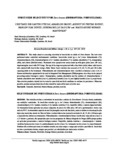Please use this identifier to cite or link to this item:
http://www.alice.cnptia.embrapa.br/alice/handle/doc/1008783| Title: | Insecticide selectivity for Doru lineare (Dermaptera: Forficulidae). |
| Authors: | STECCA, C. dos S.  PASINI. A.   BUENO, A. de F.   DENEZ, M. D.   SILVA, D. M. da   MONTOVANI, M. A. M.   |
| Affiliation: | CRISTIANE DOS SANTOS STECCA, UEL; AMARILDO PASINI, UEL; ADENEY DE FREITAS BUENO, CNPSO; MARLON DIAS DENEZ, UEL; DEBORA MELLO DA SILVA, UEL; MAICO ANDRE MORAES MANTOVANI, UniFil. |
| Date Issued: | 2014 |
| Citation: | Revista Brasileira de Milho e Sorgo, Sete Lagoas, v. 13, n. 1, p. 107- 115, jan./abr. 2014. |
| Description: | ABSTRACT - This study aimed at assessing selectivity of insecticides to adults of Doru lineare. The tests were performed under controlled environmental conditions. Insecticides tested (g a.i. ha-1) were: flubendiamide (72); chlorantraniliprole (30); chlorantraniliprole (15) + lambda-cyhalothrin (7.5); lambda-cyhalothrin (7.5); chlorpyriphos (480); and control (distilled water). Treatments were sprayed over arenas made up with glass plates (area 169 cm2), imprisoning the insect with PVC rings. The top of the rings was protected with a fine fabric (tulle) where adult insects were sprayed with insecticides using a Potter Tower. Insect survival was assessed at 24, 48, 72, 96, and 120 h after exposing adults to the treatments. Flubendiamide and chlorantraniliprole were classified as harmless (class 1) to D. lineare and therefore apropriated to be used in Integrated Pest Management (IPM) programs since they can be sprayed preserving natural biological control. Chlorpyriphos, lambda-cyhalothrin and the mixture of chlorantraniliprole + lambda-cyhalothrin were harmful (class 4), moderately harmful (class 3), and slightly harmful (class 2), respectively. Non-selective products should also be tested in semi-field and field conditions to evaluate its persistence. Whenever possible, noxious and persistent insecticides should be replaced for more selective ones. RESUMO - Este trabalho avaliou a seletividade de inseticidas a adultos de Doru lineare. Os testes foram conduzidos em condições controladas. Os inseticidas testados (g i.a. ha-1) foram: flubendiamida (72); clorantraniliprole (30); clorantraniliprole (15) + lambda-cialotrina (7,5); lambda-cialotrina (7,5); clorpirifós (480); e controle (água destilada). Os tratamentos foram aplicados em arenas compostas de placas de vidro (área 169 cm2 ), aprisionando o inseto com anéis de PVC. A extremidade superior do anel foi protegida com tecido fino (tule), onde os adultos receberam aplicação tópica dos inseticidas através de Torre de Potter. A sobrevivência dos insetos foi avaliada 24, 48, 72, 96 e 120 horas após a exposição dos adultos aos tratamentos. Flubendiamida e clorantraniliprole foram classificados como inócuo (classe 1) a D. lineare e, portanto, são apropriados para uso em programas de Manejo Integrado de Pragas (MIP) porque podem ser aplicados preservando o controle biológico natural. Clorpirifós, lambda-cialotrina e clorantraniprole + lambdacialotrina foram nocivo (classe 4), moderadamente nocivo (classe 3) e levemente nociva (classe 2), respectivamente. Produtos não seletivos precisam ser também testados em semi-campo e campo para avaliar a persistência. Inseticidas nocivos e persistentes devem, sempre que possível, ser substituídos por outros mais seletivos. |
| Thesagro: | Inseticida Predador Inimigo natural Toxidez Milho Controle integrado Praga de planta |
| NAL Thesaurus: | Predators Insecticides Natural enemies Toxicity Corn Integrated pest management Plant pests Crop entomology |
| Keywords: | Diamida Piretróide Pyretroid Dyamide Dora lineare |
| ISSN: | 1980-6477 |
| Type of Material: | Artigo de periódico |
| Access: | openAccess |
| Appears in Collections: | Artigo em periódico indexado (CNPSO)  |
Files in This Item:
| File | Description | Size | Format | |
|---|---|---|---|---|
| INSECTICIDESELECTIVITYFORDorulineare.pdf | 315.68 kB | Adobe PDF |  View/Open |









